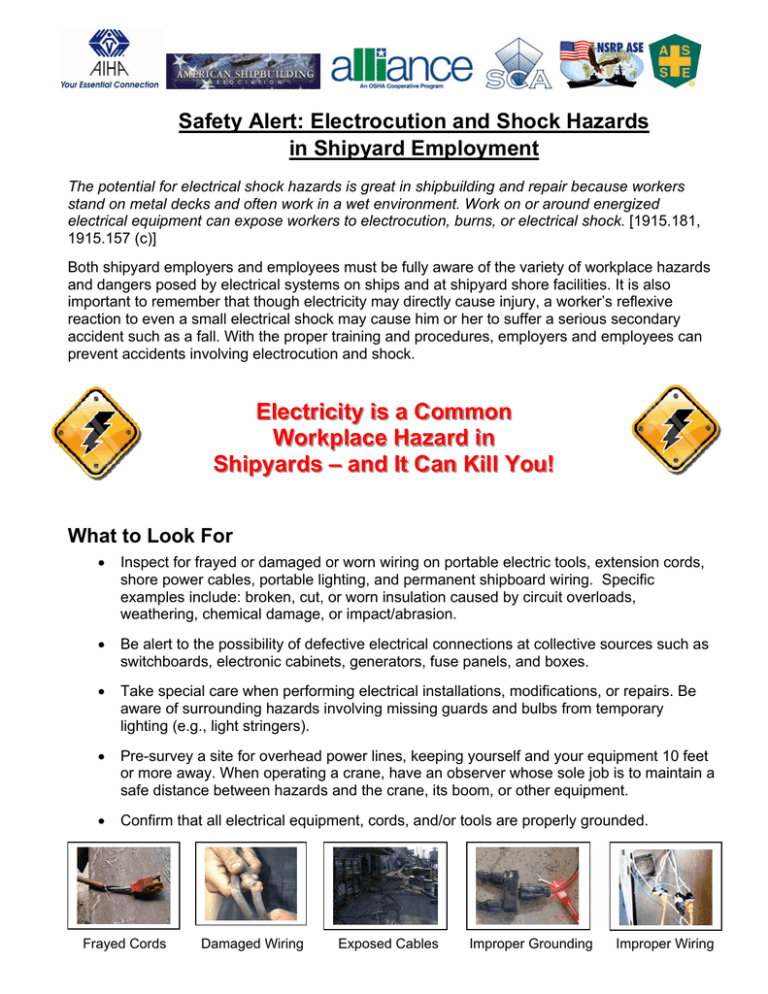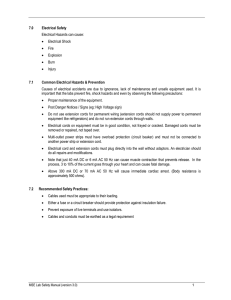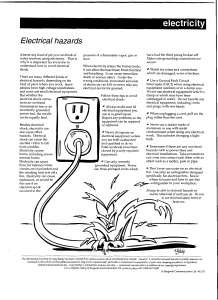Safety Alert: Electrocution and Shock Hazards in Shipyard
advertisement

Safety Alert: Electrocution and Shock Hazards in Shipyard Employment The potential for electrical shock hazards is great in shipbuilding and repair because workers stand on metal decks and often work in a wet environment. Work on or around energized electrical equipment can expose workers to electrocution, burns, or electrical shock. [1915.181, 1915.157 (c)] Both shipyard employers and employees must be fully aware of the variety of workplace hazards and dangers posed by electrical systems on ships and at shipyard shore facilities. It is also important to remember that though electricity may directly cause injury, a worker’s reflexive reaction to even a small electrical shock may cause him or her to suffer a serious secondary accident such as a fall. With the proper training and procedures, employers and employees can prevent accidents involving electrocution and shock. E Elleeccttrriicciittyy iiss aa C Coom mm moonn W Haazzaarrdd iinn Woorrkkppllaaccee H S Kiillll Y Yoouu!! Shhiippyyaarrddss –– aanndd IItt C Caann K What to Look For • Inspect for frayed or damaged or worn wiring on portable electric tools, extension cords, shore power cables, portable lighting, and permanent shipboard wiring. Specific examples include: broken, cut, or worn insulation caused by circuit overloads, weathering, chemical damage, or impact/abrasion. • Be alert to the possibility of defective electrical connections at collective sources such as switchboards, electronic cabinets, generators, fuse panels, and boxes. • Take special care when performing electrical installations, modifications, or repairs. Be aware of surrounding hazards involving missing guards and bulbs from temporary lighting (e.g., light stringers). • Pre-survey a site for overhead power lines, keeping yourself and your equipment 10 feet or more away. When operating a crane, have an observer whose sole job is to maintain a safe distance between hazards and the crane, its boom, or other equipment. • Confirm that all electrical equipment, cords, and/or tools are properly grounded. Frayed Cords Damaged Wiring Exposed Cables Improper Grounding Improper Wiring Preventing and Eliminating Electrical Safety and Shock Hazards Always…….. • Ensure that energized equipment is de-energized, guarded, appropriately locked or tagged out, and proper PPE used to prevent worker exposure before work is performed. • Follow appropriate protocol for the control of hazardous energy, including your company’s established Lock Out/Tag Out procedures. • Do not to bypass any protective system or device (e.g., interlocks, barriers) designed to protect employees from contact with electrical energy. • Ensure all electrical equipment, wiring, and cables are in safe working condition. • Ensure multiple conductor cables are protected against strain when working overhead crane push-button stations. • Ensure proper care in the routing of all wiring, avoiding sharp bends and pinch points. • Ensure all electrical equipment and/or tools are properly grounded. • Wear safety glasses or face shields and insulated gloves when exposed to any electrical hazards including work on energized electrical systems. • Ensure that ladders, scaffolds, equipment, or materials never come within 10 feet of electric power lines. • Use portable electric hand tools with switches that must be manually held closed. • Ensure proper electric equipment and types of lighting, such as dust-proof or explosionproof lighting, are used in hazardous atmospheres. De-Energize Circuits Perform Lock Out/Tag Out Wear Correct PPE Use Grounded Outlets Through OSHA’s Alliance Program, this Safety Alert was developed as a product of the Alliances OSHA has signed with the American Industrial Hygiene Association, the American Society of Safety Engineers, the American Shipbuilding Association, the National Shipbuilding Research Program, and the Shipbuilders Council of America. It is for informational purposes only and does not necessarily reflect the official views of OSHA or the U.S. Department of Labor. 2/5/08


